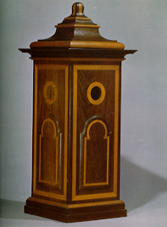
67 x 27 x 27
Carved wood and zinc
INDEX 1788 : T.IV.302
Capsula lignea undique clausa, sed tamen foramine pertusa, quod recta permeant radii candelae ardentis intus positae; ad ostendendum lucis densitatem in mayore intervallo a centro lucente decrescere in ratione duplicata reciproca distantiarum.
Wooden box closed on all sides but in all crossed by an orifice that the rays of a lit candle placed inside cross in a straight line; to show that the density of light, at an increased distance from the luminous centre diminishes, in reciprocal duplicated ratio to the distances.
Here we are dealing with a box in a prismatic shape with a quadrangular base, and a lid on top, whose shape suggests pyramids placed on top of one another. On one side of the box, there is a small door used to put candles in the box. On the opposite side, slightly above the upper part of the door, there is a circular orifice 4.5 cm in diameter. The other sides have, at the same level as this orifice, circular inlaid work with the same dimensions as the orifice. All of the sides of the box have geometrical shapes at the level of the door, in inlaid wood, which suggest false doors.
The experiments were performed by placing a lit candle inside the box and by removing the lid in order to keep the candle lit. When the assemblage was placed in a dark room, the orifice allowed the candle to illuminate an object, for example, a page from a book, which had to be placed at a distance from the orifice that would make it difficult to read the page. So that the conditions of illumination of this page would be identical to these conditions when the same page was re-located at a distance twice as far as the first, it was necessary to place a group of 4 candles in the box. Thus, the teacher of experimental physics could show that the intensity of the illumination of a target produced by a source of light diminished as the target was moved away from the source, in inverse proportion to the square of the distance at which it was placed.
From Colégio dos Nobres, catalogue n.º 292.Musschenbroek, Peter van, Introductio ad Philosophiam Naturalem, Leiden, 1762, Vol. II, § 1675. Tab. XXXV, Fig. 7.